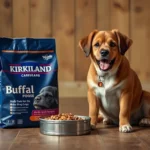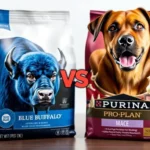
Introduction
Proper nutrition is crucial for ensuring our canine companions lead healthy and happy lives. Just like humans, dogs require a balanced diet tailored to their specific needs, which can vary based on age, breed, and health status. Among the many options available in the pet food market, Cesar dog food stands out as a popular choice for many dog owners. This article aims to provide a comprehensive Cesar dog food review, covering everything from ingredients and nutritional value to the suitability of the brand for different dog breeds and ages.
Understanding Dog Nutrition
Importance of Proper Nutrition for Dogs
Dog nutrition significantly affects a dog’s overall health, energy levels, and longevity. A well-balanced diet can help prevent common health issues such as obesity, diabetes, and digestive problems. Conversely, nutritional deficiencies can lead to a host of problems, including poor coat condition, lethargy, and a weakened immune system.
Nutritional Needs by Age and Breed
Dogs have different dietary requirements depending on their age and breed size. Puppies require nutrient-dense food to support their rapid growth and development, while adult dogs need a balanced diet to maintain their health. Senior dogs often benefit from specialized formulas that address age-related health concerns. Additionally, the size of a dog—small, medium, or large—can influence its nutritional needs, necessitating specific caloric and protein levels.
Overview of Cesar Dog Food
Brand History and Reputation
Cesar has been a well-known name in the pet food industry for many years. Launched in the 1980s, the brand gained popularity by offering high-quality wet dog food specifically designed for small breeds. Cesar has cultivated a reputation for providing convenient, flavorful meals that many dogs love.
Product Range
Cesar offers a diverse range of products tailored to meet the needs of small and toy dog breeds. Their product lineup includes:
- Wet Food: A variety of flavors, including chicken, beef, and lamb in convenient trays.
- Dry Food: Formulated for small breeds with different flavor profiles.
- Treats: Snacks designed to complement the main diet.
Cesar also provides special formulas, such as grain-free options and limited ingredient diets, catering to dogs with specific dietary needs.
Ingredients Analysis
Key Ingredients Used in Cesar Dog Food
One of the critical aspects of any dog food is its ingredient list. Cesar dog food primarily features meat as its first ingredient, which is essential for a dog’s health. Common ingredients in Cesar products include:
- Real meat (chicken, beef, lamb)
- Meat by-products
- Grains (in some formulations)
- Vegetables and fruits
- Vitamins and minerals
Nutritional Analysis
A comprehensive Cesar dog food review wouldn’t be complete without examining its nutritional value. Cesar dog food typically contains a guaranteed analysis that includes:
- Protein: 8% – 10%
- Fat: 4% – 6%
- Fiber: 1% – 2%
- Moisture: 78% – 82%
These levels often align with AAFCO standards for complete and balanced dog food. However, it’s crucial for pet owners to compare these values with their dog’s unique nutritional needs.
Pros and Cons of Ingredients
Cesar dog food has several advantages, particularly its focus on high-quality meat ingredients that provide essential protein. However, there are potential concerns regarding the inclusion of by-products and preservatives. While by-products can be a source of protein, some dog owners prefer to avoid them in favor of whole meat sources.
Feeding Guidelines
Recommended Serving Sizes
Feeding guidelines for Cesar dog food vary based on a dog’s weight and activity level. Generally, the recommended serving sizes are as follows:
- Small Dogs (under 10 lbs): 1 to 1.5 trays per day
- Medium Dogs (10-20 lbs): 1.5 to 2.5 trays per day
- Large Dogs (over 20 lbs): 2.5 to 3 trays per day
It’s also essential to consider feeding frequency, with most dogs benefiting from two meals a day.
Transitioning to Cesar Dog Food
Switching to Cesar dog food should be done gradually to minimize digestive issues. A typical transition plan involves mixing the new food with the old food over about a week. Watch for signs of food intolerance or allergies, such as vomiting, diarrhea, or excessive scratching, during this transition period.
Customer Reviews and Testimonials
Summary of Consumer Feedback
Overall, customer feedback on Cesar dog food tends to be positive. Many dog owners praise the brand for its taste, variety, and convenience. Dogs often seem to enjoy the flavors, making it easier for owners to find a meal their pets love.
Negative Reviews and Criticisms
Despite the favorable reviews, some customers have raised concerns about ingredient quality and formulation. Common complaints include the presence of by-products and artificial preservatives. It’s essential for dog owners to weigh these concerns against their dogs’ preferences and dietary needs.
Comparison with Other Dog Food Brands
Comparison Criteria
When evaluating Cesar dog food against other brands, several factors come into play:
- Price: Cesar is often considered budget-friendly.
- Quality: The quality of ingredients can vary significantly between brands.
- Availability: Cesar products are widely available in stores and online.
Side-by-Side Nutritional Comparison
| Brand | Protein (%) | Fat (%) | Fiber (%) | Moisture (%) |
|---|---|---|---|---|
| Cesar (Wet Food) | 8-10 | 4-6 | 1-2 | 78-82 |
| Blue Buffalo | 10-12 | 5-7 | 3-4 | 10-12 |
| Purina Pro Plan | 18-22 | 8-10 | 2-4 | 10-12 |
| Royal Canin | 25-30 | 8-10 | 3-4 | 10-12 |
Cesar dog food is designed primarily for small breeds and offers a different nutritional profile compared to competitors like Blue Buffalo or Royal Canin, which may be more suitable for larger breeds or specific health concerns.
Conclusion
In summary, the Cesar dog food review highlights the brand’s commitment to providing tasty and convenient meals primarily for small dogs. With a focus on quality ingredients and a variety of flavors, Cesar is a strong contender in the pet food market. However, potential buyers should consider their dogs’ specific needs and dietary requirements when selecting food. Ultimately, whether Cesar dog food is the right choice will depend on individual preferences and health considerations.
FAQs
Is Cesar dog food suitable for all dog breeds?
Cesar dog food is primarily designed for small and toy breeds. While it may be suitable for some medium-sized dogs, larger breeds typically require different nutritional profiles.
Can Cesar dog food be mixed with other brands?
Yes, mixing Cesar dog food with other brands can be beneficial, especially during the transition period. However, ensure that the combined food meets your dog’s overall nutritional needs.
What should I do if my dog refuses to eat Cesar dog food?
If your dog refuses to eat Cesar dog food, try mixing it with a favorite treat or food. Gradually introducing the food may encourage them to give it a try.
Where can I purchase Cesar dog food?
Cesar dog food is widely available in pet stores, supermarkets, and online retailers, making it accessible for dog owners looking for convenient meal options.
Are there any recalls on Cesar dog food?
Cesar dog food has had a few recalls in the past, as is common with many pet food brands. It’s always a good idea to stay informed about product recalls by checking reliable sources and manufacturer announcements.
In conclusion, Cesar dog food offers a variety of options, appealing to many dog owners. While it has its pros and cons, understanding your dog’s specific needs will help you make the best choice for their diet.









